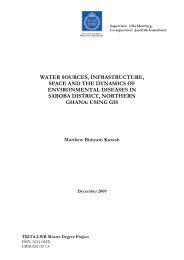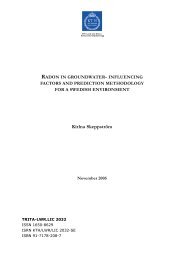Comparison between 1D and 2D models to analyze the dam break
Comparison between 1D and 2D models to analyze the dam break
Comparison between 1D and 2D models to analyze the dam break
- No tags were found...
You also want an ePaper? Increase the reach of your titles
YUMPU automatically turns print PDFs into web optimized ePapers that Google loves.
<strong>Comparison</strong> <strong>between</strong> <strong>1D</strong> <strong>and</strong> <strong>2D</strong> <strong>models</strong> <strong>to</strong> <strong>analyze</strong> <strong>the</strong> <strong>dam</strong> <strong>break</strong> wave - Appendixreservoir dykes, <strong>and</strong> river beds, regular grid applicationis used. For o<strong>the</strong>r features such as railways,embankments, <strong>and</strong> constraint lines are imposed. All<strong>the</strong>se features are quite visible on <strong>the</strong> mesh.Urban areas <strong>and</strong> floating debrisIt is necessary <strong>to</strong> develope methods <strong>to</strong> calculate floodwave propagation in urban area. Some <strong>models</strong> use <strong>the</strong>geometry approach <strong>and</strong> houses are taken in<strong>to</strong> accountin model geometry. O<strong>the</strong>r <strong>models</strong> use <strong>the</strong> porosityapproach.In <strong>the</strong> first model, <strong>the</strong> geometry is represented by agrid consisting of rectangles (10x10 metres forinstance). Generally, <strong>the</strong> calculated water levels arehigher in <strong>the</strong> cases where buildings where taken in <strong>to</strong>account (maximum difference about 0,5 m). Thepropagation of a flood wave is generally a bit slowerwhen <strong>the</strong> buildings are taken in<strong>to</strong> account. However,<strong>the</strong> effect on propagation speed is not very significant.The effect of buildings on <strong>dam</strong>age parameter is notvery significant <strong>and</strong> can not be seen as very importantfor <strong>the</strong> planning of emergency actions. However, insome specific cases <strong>the</strong> effect can be important.Analyses of <strong>the</strong> resultsThe following analyses can be simulated during <strong>the</strong>project, for instance:RUN 1Base flow (HQ 1/100 ) + breach hydrograph for maxreservoir level, roughness varies <strong>between</strong> Strickler 15(Manning's n = 0,06666) <strong>and</strong> 40 (Manning's n =0,025).RUN 2Base flow <strong>and</strong> breach hydrograph as in RUN 1,roughness is constant for <strong>the</strong> entire modelling areawith Strickler 15 (Manning's n = 0,06666).RUN 3MQ base flow + breach hydrograph, constantManning n varying in <strong>the</strong> entire modelling areaaccording <strong>to</strong> l<strong>and</strong> formation <strong>and</strong> vegetation.RUN 4HQ 1/100 base flow + breach hydrograph, o<strong>the</strong>rconditions as in RUN 3.RUN 5Conditions of RUN 3 modified according <strong>to</strong> <strong>the</strong>choice of modelling buildings (porosity or geometry).RUN 6Conditions of RUN 4 modified according <strong>to</strong> <strong>the</strong>choice of modelling buildings (porosity or geometry).The breach location is assumed <strong>to</strong> be <strong>the</strong> same for all<strong>the</strong>se analyses.The reason behind using different <strong>models</strong> <strong>to</strong> simulate<strong>the</strong> same case is not <strong>to</strong> compare <strong>the</strong> computationalalgorithms. The reason is <strong>to</strong> get an idea how much <strong>the</strong>results differ depending on <strong>the</strong> <strong>models</strong>.The modeller uses his own judgement for choosing<strong>the</strong> friction fac<strong>to</strong>rs for different areas. The water levelcomparison is done on different locations downstreamof <strong>the</strong> <strong>dam</strong>. The progression of <strong>the</strong> <strong>dam</strong> <strong>break</strong> flood isalso compared on maps.In <strong>the</strong> case of very complicated <strong>to</strong>pography, <strong>the</strong> use ofa two-dimensional model seems <strong>to</strong> be morereasonable. The use of a 1-dimensional model needs alot of experience since <strong>the</strong> cross-sections have <strong>to</strong> beput at <strong>the</strong> right locations.Summary .To determine flow hydrographs through <strong>the</strong> <strong>dam</strong>breach opening is crucial <strong>to</strong> <strong>the</strong> results of a DBHA.There are a lot of uncertainties in <strong>the</strong> determination ofa breach hydrograph <strong>and</strong> sensitivity analyses have <strong>to</strong>be used <strong>to</strong> ensure <strong>the</strong> results.A one or two-dimensional model can be used in <strong>the</strong>calculations. The experience shows that with carefulmodelling <strong>and</strong> accurate data <strong>the</strong> results of differentmodelling approaches may be relatively close eacho<strong>the</strong>r. However, <strong>the</strong>re are a lot of uncertainties in <strong>the</strong>modelling.Several methods can be used <strong>to</strong> model <strong>the</strong> flow inurban areas (porosity or geometry approach). Theconcrete results of a <strong>dam</strong> <strong>break</strong> hazard analysis foremergency action planning consist of inundationmaps, water depth maps, <strong>dam</strong>age parameter (flowvelocity times water depth) maps as well as water level<strong>and</strong> velocity hydrographs <strong>and</strong> tables. The results ofDBHA should be presented in such a way that <strong>the</strong>ycan be used efficiently in <strong>the</strong> emergency/rescue actionplanning <strong>and</strong> risk analysis. The use of <strong>the</strong>Geographical Information System (GIS) is essentialfor that purpose.C) EMERGENCY ACTION PLANNINGIntroductionThe main purpose of <strong>the</strong> RESCDAM project was <strong>to</strong>develop emergency action planning in <strong>the</strong> event of a<strong>dam</strong> failure. The <strong>to</strong>pics of <strong>the</strong> emergency actionplanning are approached from <strong>the</strong> point of view ofrescue authorities.Dam safety is an issue for a few people only, such as<strong>dam</strong> owners or <strong>dam</strong> holders, <strong>the</strong> rescue <strong>and</strong>environmental authorities. Only a few of <strong>the</strong>se peoplehave been faced with a serious <strong>dam</strong> failure or <strong>dam</strong>emergency situation. In case of an extensive accident,situation management is almost impossible withoutadvance planning. Lack of experience is also aproblem when considering <strong>the</strong> emergency action planof a <strong>dam</strong>. It is difficult <strong>to</strong> prepare an emergency actionplan for an event that can only be imagined.Organizing <strong>the</strong> warning <strong>and</strong> evacuation of <strong>the</strong>population <strong>and</strong> rescue operations in a <strong>dam</strong> failuresituation.Dam failure is an extremely dem<strong>and</strong>ing accidentsituation <strong>to</strong> everyone involved. A strong water flow,varying water depth, floating debris, <strong>dam</strong>aged road27
















